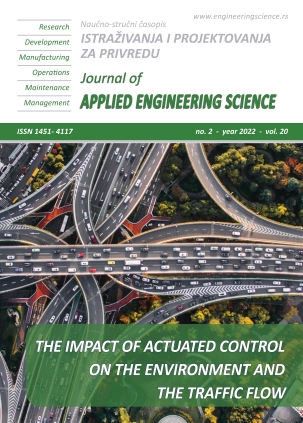PRACTICAL APPLICATION OF SIX SIGMA METHODOLOGY TO REDUCE DEFECTS IN A PAKISTANI MANUFACTURING COMPANY
Abstract
All over the world six sigma is being adopted as a quality improvement approach towards zero defects. Unfortunately, the adoption of the six sigma methodology in manufacturing companies is very rare in developing countries due to different challenges and Pakistan is standing in the same row. This article demonstrates the practical use of various six sigma tools throughout Define, Measure, Analyze, Improve and Control (DMAIC) cycle by conducting a case study of manufacturing company in Pakistan. The potential problem was the external leakage defect in refrigerator during its production. The goal of this project was to identify critical root causes of external leakage and eliminate them with the help of six sigma DMAIC methodology. Project charter, Pie chart, Bar chart of faults, Suppliers Input Process Output (SIPOC), Voice of Customer (VOC) and flow process map were used to define the problem, its scope and process routing. Pareto chart was used to identify sub defects and sigma level was calculated for the existing process. Feed rate, capillary action of filler material, cleanliness, visual inspection and unsuitable heat input were the major causes of external leakage, identified by cause and effect diagram. Cause and effect matrix was developed to rank the identified causes. Further, DoE was performed to improve the process by conducting different alterations in the parameters. In order to control the process, FMEA sheet was prepared to sustain the process improvements. The FMEA control plan needed to be revised at specific time intervals to attain continuous process improvement. External leakage defect was reduced by 30% and service call rate (SCR) was improved with lower complaints from customers.
References
Pande, P.S., R.P. Neuman, and R.R. Cavanagh, The six sigma way: How GE, Motorola, and other top companies are honing their performance. 2000: McGraw-Hill (New York).
Sinha, P.K. and N.N. Singh, The Advancement & Effect of Six Sigma Approach in a Modern Industry and Current Business Enterprise. International Journal of Mechanical Engineering & Technology (IJMET), 2013. 4(3): p. 32-46.
Youssouf, A., C. Rachid, and V. Ion, Contribution to the optimization of strategy of maintenance by lean six sigma. Physics Procedia, 2014. 55: p. 512-518.
Simanová, Ľ., Specific Proposal of the Application and Implementation Six Sigma in Selected Processes of the Furniture Manufacturing. Procedia Economics and Finance, 2015. 34: p. 268-275.
Banuelas, R., J. Antony, and M. Brace, An application of Six Sigma to reduce waste. Quality and Reliability Engineering International, 2005. 21(6): p. 553-570.
Antony, J., et al., Application of Six Sigma DMAIC methodology in a transactional environment. International Journal of Quality & Reliability Management, 2012. 29(1): p. 31-53.
Panayiotou, N.A., K.E. Stergiou, and N. Panagiotou, Using Lean Six Sigma in small and medium-sized enterprises for low-cost/high-effect improvement initiatives: a case study. International Journal of Quality & Reliability Management, 2021.
Adeodu, A., M.G. Kanakana-Katumba, and M. Rendani, Implementation of Lean Six Sigma for production process optimization in a paper production company. Journal of Industrial Engineering and Management, 2021. 14(3): p. 661-680.
Costa, J., I.d.S. Lopes, and J. Brito, Six Sigma application for quality improvement of the pin insertion process. Procedia Manufacturing, 2019. 38: p. 1592-1599.
Albliwi, S.A., J. Antony, and S.A. halim Lim, A systematic review of Lean Six Sigma for the manufacturing industry. Business Process Management Journal, 2015.
Legesse, B. and S. Geremew, Minimizing Costs of Poor Quality for Glass Container Bottles Production Using Six Sigma’s Dmaic Methodology: A Case Study in a Bottle and Glass Share Company. Industrial Engineering, 2021. 5(1): p. 7.
Antony, J., et al., Using Six Sigma DMAIC for Lean project management in education: a case study in a German kindergarten. Total Quality Management & Business Excellence, 2021: p. 1-21.
Ben Romdhane, T., A. Badreddine, and M. Sansa, A new model to implement Six Sigma in small-and medium-sized enterprises. International Journal of Production Research, 2017. 55(15): p. 4319-4340.
Antony, J. and M. Kumar, Lean and Six Sigma methodologies in NHS Scotland: an empirical study and directions for future research. Quality Innovation Prosperity, 2012. 16(2): p. 19-34.
Kaswan, M.S. and R. Rathi, Green Lean Six Sigma for sustainable development: Integration and framework. Environmental impact assessment review, 2020. 83: p. 106396.
Cherrafi, A., et al., A framework for the integration of Green and Lean Six Sigma for superior sustainability performance. International Journal of Production Research, 2017. 55(15): p. 4481-4515.
Antony, J., et al., A multiple case study analysis of Six Sigma practices in Indian manufacturing companies. International Journal of Quality & Reliability Management, 2016.
Kumar, M., et al., Implementing the Lean Sigma framework in an Indian SME: a case study. Production Planning and Control, 2006. 17(4): p. 407-423.

